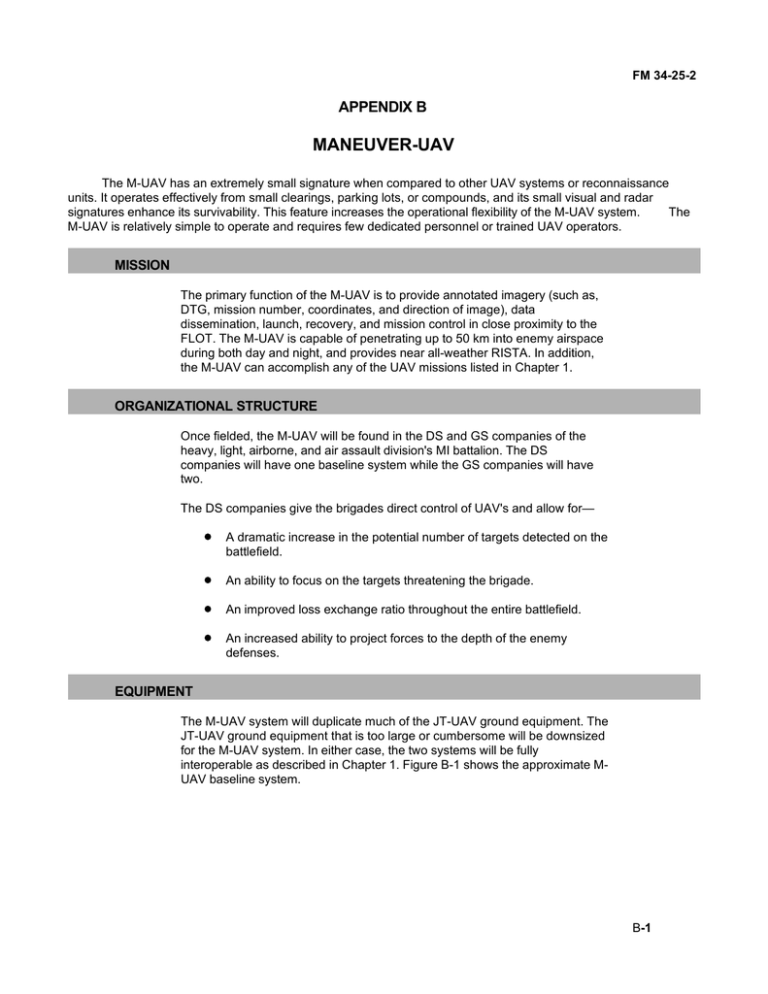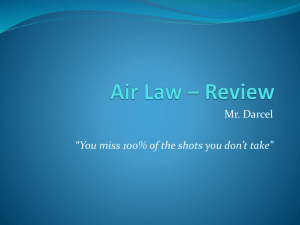MANEUVER-UAV APPENDIX B
advertisement

FM 34-25-2 APPENDIX B MANEUVER-UAV The M-UAV has an extremely small signature when compared to other UAV systems or reconnaissance units. It operates effectively from small clearings, parking lots, or compounds, and its small visual and radar signatures enhance its survivability. This feature increases the operational flexibility of the M-UAV system. The M-UAV is relatively simple to operate and requires few dedicated personnel or trained UAV operators. MISSION The primary function of the M-UAV is to provide annotated imagery (such as, DTG, mission number, coordinates, and direction of image), data dissemination, launch, recovery, and mission control in close proximity to the FLOT. The M-UAV is capable of penetrating up to 50 km into enemy airspace during both day and night, and provides near all-weather RISTA. In addition, the M-UAV can accomplish any of the UAV missions listed in Chapter 1. ORGANIZATIONAL STRUCTURE Once fielded, the M-UAV will be found in the DS and GS companies of the heavy, light, airborne, and air assault division's MI battalion. The DS companies will have one baseline system while the GS companies will have two. The DS companies give the brigades direct control of UAV's and allow for— A dramatic increase in the potential number of targets detected on the battlefield. An ability to focus on the targets threatening the brigade. An improved loss exchange ratio throughout the entire battlefield. An increased ability to project forces to the depth of the enemy defenses. EQUIPMENT The M-UAV system will duplicate much of the JT-UAV ground equipment. The JT-UAV ground equipment that is too large or cumbersome will be downsized for the M-UAV system. In either case, the two systems will be fully interoperable as described in Chapter 1. Figure B-1 shows the approximate MUAV baseline system. B-1 FM 34-25-2 CAPABILITIES The following capabilities have been identified in the M-UAV master fielding plan: Cruise speed . . . . . . . . . . . . . . . . . . . . . . . . . . . . . . . . . 75 kts. Maximum altitude . . . . . . . . . . . . . . . . . . . . . . . . . . . 10,000 ft. Endurance . . . . . . . . . . . . . . . . . . . . . . . . . . . . . . . . . . . . 3 hrs. Modular mission payload . . . . Stabilized day/night imagery. Data link . . . . . . . . . . . . . . . . . . . . . . . . . . . . . . . . . . . . . 50 km. B-2 FM 34-25-2 LIMITATIONS The exact limitations will depend on the UAV that is fielded. The following limitations are inherent to the M-UAV system: Reduced size and limited endurance of the M-UAV will require repetitive launches to maintain surveillance for extended periods. Reduced size of the ground stations means that complete analysis of payload products requires support from other sources. The AV and the GCS nonencrypted signals are exploitable by threat EW systems. The AV and current payloads are not hardened and therefore vulnerable to threat small arms, antiaircraft artillery (AAA), or laser. AIRSPACE MANAGEMENT IN SUPPORT OF MILITARY OPERATIONS The airspace management of the M-UAV is accomplished through the combined use of ROZs and blanket altitudes as described in Chapter 3. Responsibilities for obtaining airspace are also described in Chapter 3. All manned aircraft working in the vicinity of a UAV unit will check with the appropriate airspace control agency on arrival and be advised of UAV status. The following information is available from the airspace control agency: ROZ location and status. UAV blanket altitude height and status. UAVs current location and altitude. The UAV mission flight crew can change the flight route, altitude, or location of the UAV, if directed, by the appropriate airspace command authority. NATIONAL AIRSPACE SYSTEM Airspace management in the NAS is outlined in Chapter 3. The M-UAV must follow all of the FAA regulations and ARs that apply. OPERATIONS As in all other systems, tasking will drive mission planning. Due to its robust capabilities, a number of options are available in system deployment. Based on the requirements of the mission and the UAV's capabilities, a detailed mission plan will be developed. All essential elements must be considered and included in the plan, including site selection and availability, airspace coordination, weather, target location, collection requirements, the threat, payload, fuel requirements, altitude, speed, loiter times, crew manning, UAV return home locations, and emergency recovery options. Mission planning is the responsibility of the UAV team performing the mission. B-3 FM 34-25-2 EMPLACEMENT While many variations are possible, the normal configuration for M-UAV emplacement is a single site operation. The site selection criteria are explained in Chapter 2, but the size of the launch area needs to be approximately 30 m x 75 m x 10 m. TRANSPORTABILITY The M-UAV system is capable of being transported in a C-130 or larger aircraft. Separate components can be lifted by a CH-47 or CH-53. The system is required to be configured for air, rail, or marine transport in two hours or less. The ground components will be mounted on HMMWVs. B-4




